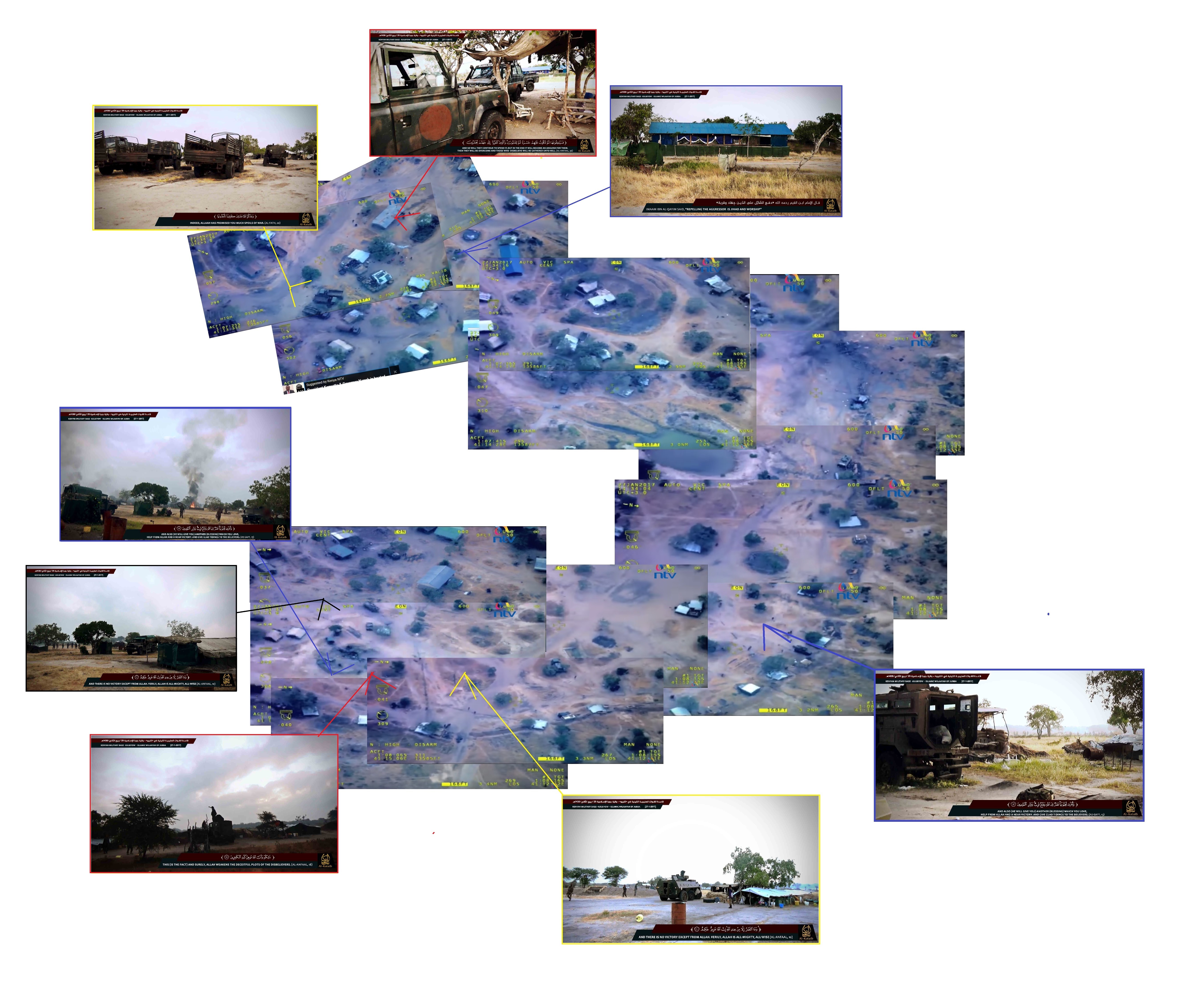What Happened in Kulbiyow, Somalia: An Open Source Investigation
The Official Story
On Friday January 27, a Kenyan Defense Force (KDF) military installation in the Somalian village of Kulbiyow was attacked by militants from the al-Qaeda affiliated group al-Shabaab. In the immediate aftermath, significant uncertainty existed as to the outcome of the attack. In an official statement, Kenyan official estimates placed KDF casualties at only nine and al-Shabaab dead at over 70. The official statement described a scenario in which Kenyan troops successfully repelled a massive al-Shabaab attack, which included two vehicle-borne improvised explosive devices (VBIEDs). State House Spokesman Manoah Esipisu claimed that at no point had al-Shabaab forces breached the base’s perimeter. Further reports highlighted firsthand accounts by soldiers at the base, who detailed a successful, albeit frantic defense of the base.
Background
Kenyan forces first entered southern Somalia during Operation Linda Nchi in late 2011, driving al-Shabaab militants back from a series of bases along the countries’ shared border. Shortly thereafter, Kenya agreed to place their forces under the mandate of the African Union Mission to Somalia (AMISOM), which had been involved in peacekeeping operations in support of the Somalian government since 2007. By 2012, Kenyan and allied Somalian forces had captured al-Shabaab’s last major southern stronghold and the capital of Juba region, Kismayo. As part of the AMISOM mandate, Kenyan forces assumed responsibilities for “Sector 2”, comprised of the southern regions of Lower and Middle Juba.
In January of 2016, al-Shabaab attacked a Kenyan forward operation base in El-Adde, a town in the Gedo region of Somalia. During the attack, around 150 Kenyan soldiers were killed as militants overran the base. The attack on El-Adde followed a number of successful al-Shabaab attacks on isolated AMISOM and Somalian National Army (SNA) bases, including a Burundian base at Leego in June of 2015, and a Ugandan base at Janaale in September of the same year. In an exhaustive report, the IPI Institute outlined many of the strategic vulnerabilities of the El-Adde base. Aside from the remote and difficult to access location, the base apparently lacked the necessary precautions to prevent VBIED attacks. While the attack received extensive international and domestic reporting and analysis, and al-Shabaab released propaganda materials highlighting video from the attack, the Kenyan government has yet to acknowledge the extent of their losses or accede to calls for an inquiry.
What Happened?
As reports citing eyewitness accounts of the Kulbiyow attack began to emerge from Somali and Kenyan media outlets, doubts grew towards the official Kenyan account. In these reports, al-Shabaab overwhelmed the KDF garrison, inflicting dozens of casualties on the defenders. These accounts were backed up when al-Shabaab released a large batch of images allegedly from the attack, showing militants in control of the base and tens of Kenyan casualties. From these images and Kenyan and Somalian news reports, a competing picture materialized of the course of events.
The Lead up to the Attack
The first warning of an al-Shabaab presence near Kulbiyow was in November of 2016, when Inspector-General of the Kenyan Police Joseph Boinnet stated that militants would take advantage of seasonal rains to infiltrate the area and launch attacks. As was the case in the El-Adde attack, local media alleged that KDF commanders possessed relevant intelligence on planned al-Shabaab attacks. The Kenyan Star newspaper, citing a Kenyan soldier at the base, claimed that superiors knew that al-Shabaab scheduled to launch an attack to commemorate El-Adde’s anniversary on January 15. On the Twitter page Digital Kenyan Corps-COPS, which collates crime reporting within Kenya, the author cited a source with al-Shabaab’s internal security force, Amniyat, which claimed around 150 al-Shabaab fighters had gathered near the Kenyan town of Hulugho, 20km south of Kulbiyow, with the intent of launching an El-Adde style attack on its anniversary.
Both Kenyan and al-Shabaab forces had been active in the region prior to January 27. Al-Shabaab militants had attacked a Kenyan convoy near Kulbiyow, as well as troops based in Hulugho, in the preceding months. Kenyan and Somalian forces had launched an abortive attack on the town of Badhadhe, to the northeast of Kulbiyow, two days prior to the attack, which the KDF had abandoned in the wake of the El-Adde attack. Subsequent reporting alleged that al-Shabaab launched and planned the attack on Kulbiyow from Badhadhe.
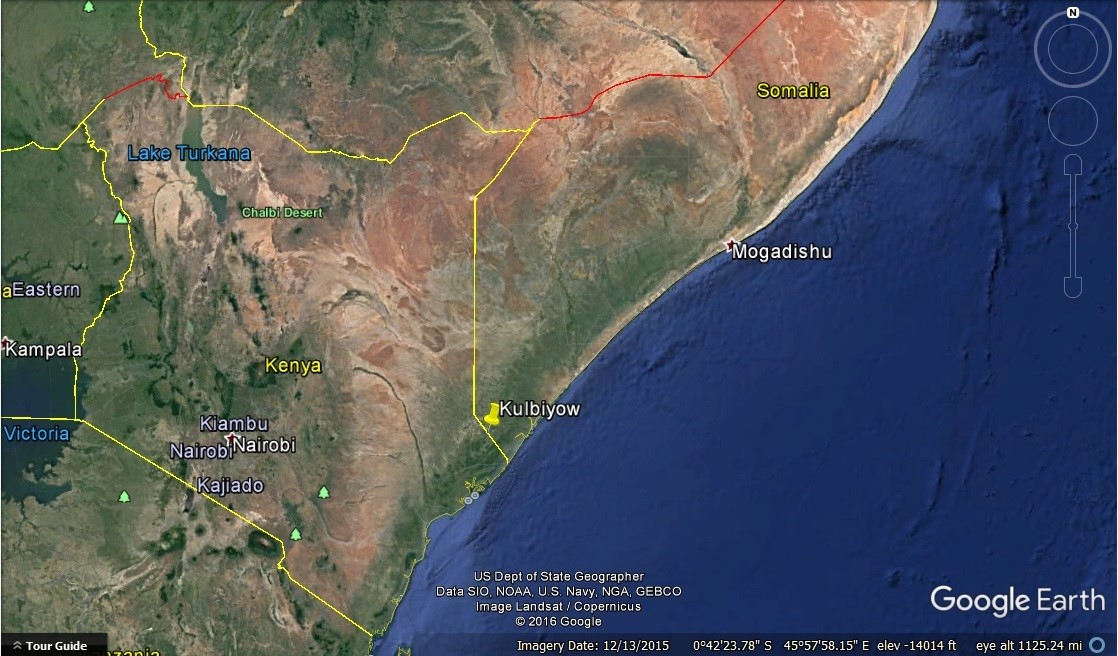
Imagery via Google Earth
The KDF forces based at Kulbiyow were comprised of 120 men from the 15th Kenya Rifles Battalion, which had replaced its predecessor only in the previous month, alongside an unspecified Somalian garrison. According to media and analyst accounts, al-Shabaab’s attacking force came from the Saleh Nahban Brigade, named in tribute for a deceased Kenyan al-Qaeda operative. The Saleh Nahban Brigade is responsible for the aforementioned attacks in El-Adde, Leego and Janaale.
The Attacks Launch
Major Denis Girenge, the commander of the Kenya Defence Forces camp at Kulbiyow, recounted that prior to the attack, Kenyan forces had sent out a patrol expecting al-Shabaab activity in the area. This is confirmed by at least one other account. Several accounts by Somalian and Kenyan military sources claimed that KDF drones were able to observe militants within the vicinity of the base, allowing defenders to target their positions with mortar fire. At around 5am, two VBIEDS approached the base, with at least one detonating after breaching the perimeter. Kenyan forces destroyed one additional VBIED before reaching the base. A Kenyan national was one of the VBIED’s drivers.
By one account, the initial VBIEDs accounted for a large number of the casualties among the defenders with the Standard of Kenya describing, “[The VBIED] is said to have killed at least 42 soldiers while about 25 others were felled by militants in trucks and on foot who poured into the wasted camp firing rockets and machine guns”. Around 500 militants were said to have participated in the attack. A soldier recalled to the Kenyan Daily Nation “After the explosion of the third VBIED, our defence was rendered hopeless. Al-Shabaab militants were running all over. We started running for our dear life.” A Somalian army captain described the attack as “An intense firefight that continued for close to an hour before the militants secured the complex”.
As the fighting intensified, a portion of the defenders withdrew and regrouped. This may have prevented al-Shabaab from overrunning the entire garrison, while effectively sealing the fate of the base. Citing military sources, The Standard claimed, “Two platoons consisting of 72 men survived after their commanders ordered that they retreat, in a possible tactical error in which the other two platoon took on the attackers, suffering massively before the camp was overrun.” A Kulbiyow resident stated, “She saw Kenyan soldiers streaming out of the base after the militants arrived”.
The defenders of the base were able to broadcast a distress call to neighboring Kenyan garrisons, several of which were relatively close to Kulbiyow. Al-Shabaab apparently planned for this, planting improvised explosive devices on the routes that Kenyan forces would use. IEDs killed two Kenyan police officers as they moved in to rescue KDF forces at the base. A Kenyan official stated, “Reinforcements deployed by the KDF in Kenya encountered massive IEDs along the MSR (main supply route) and had to abandon mission,” causing hours of delay. Kenyan forces were back in control of the base by January 28, with some uncertainty as to when it was recaptured.
Citing military sources, the Standard claimed that in total 68 Kenyan soldiers were killed at Kulbiyow. Former Prime Minister and opposition politician Raila Odinga lent credence to this claim, asserting, “We have now established beyond doubt that tens of our soldiers died on the line of duty in Somalia following an attack by militants.” From public burials, Kenyan and Somali media outlets tracked the names of at least twenty KDF soldiers and officers killed in Kulbiyow.
An Open Source Analysis
With only a handful of firsthand accounts, several of which present completely different accounts of the Kulbiyow battle, it is difficult to convey a clear picture of what occurred on January 27. Imagery provided by al-Shabaab and the Kenyan government provides further material to verify the course of events. While al-Shabaab released dozens of images purportedly showing militants within the camp and a handful of corpses of the defenders, Kenyan officials have cast doubt on their authenticity. Major Denis Girenge, the KDF commander at Kulbiyow stated, “There were no tanks at Kolbiyow so those images are from somewhere else. They left immediately the aircrafts started firing.” In order to counteract al-Shabaab’s claims, officials gave a crew from the Kenya NTV television station access to the base ten days after the attack, as well as a short clip taken from drone footage, purportedly showing KDF troops in control of the base at 2:34pm on January 27.
This footage, if proven to be from the base, would provide the only available imagery of the Kulbiyow base outside of al-Shabaab’s set. The base is not visible in searching publicly available imagery on Google Earth or Terraserver. The coordinates on the drone footage, 1 07.41 S 41 14.24 E, correspond to a location near Kulbiyow town. The NTV video provides an opportunity to verify al-Shabaab’s images, and confirm portions of competing accounts. Al-Shabaab released its photos prior to the KDF drone footage becoming publicly available, which would preclude the group staging its photos to resemble the base.
The NTV video shows only a limited portion of the base and its perimeter during a tour with an NTV journalist. At around the six-minute mark, Kenyan troops are shown in a fortified mortar position, where they demonstrate launching a mortar round. Before the round is fired, the camera briefly pans up to show a larger view of the base. From this view, we can match up the location of the mortar to the drone footage, as shown below, with like-colored boxes indicating shared points of interest in each image.
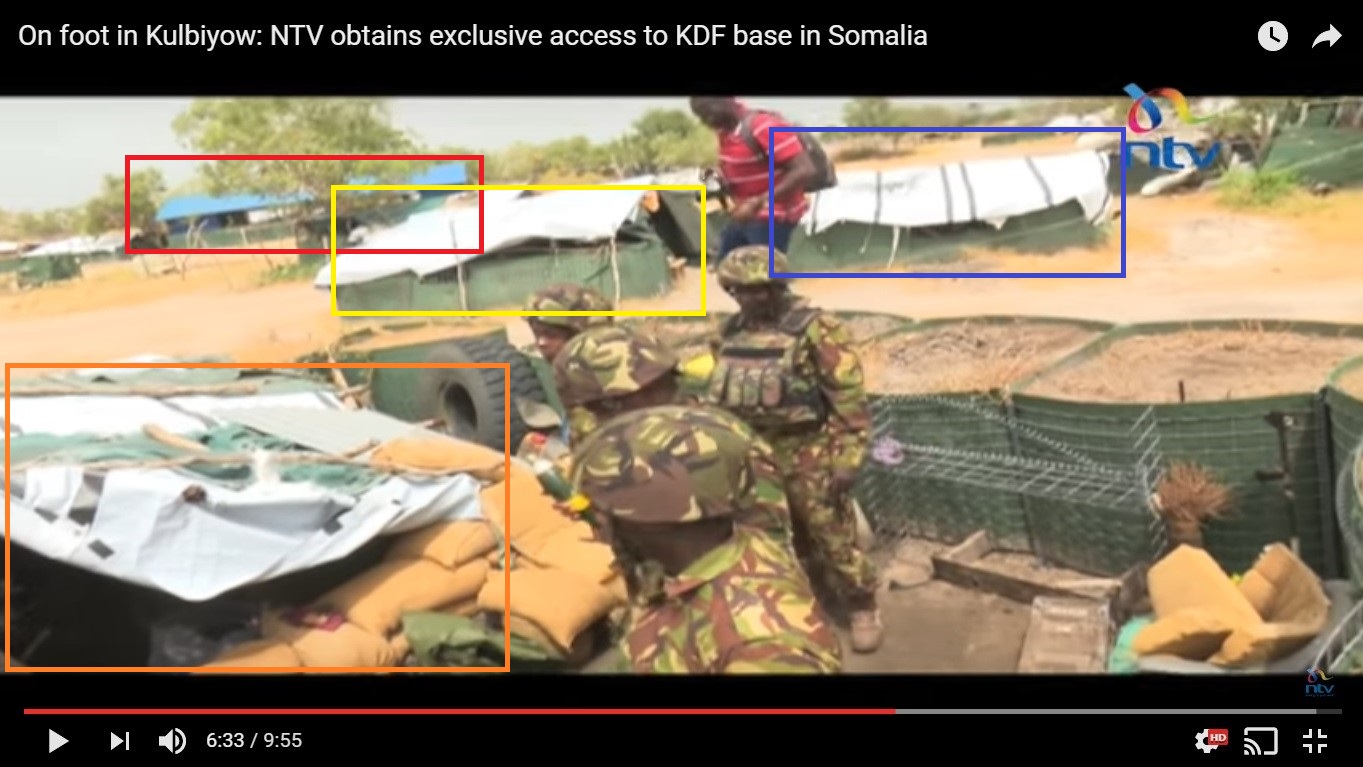
Imagery via Kenya NTV: On foot in Kulbiyow: NTV obtains exclusive access to KDF base in Somalia
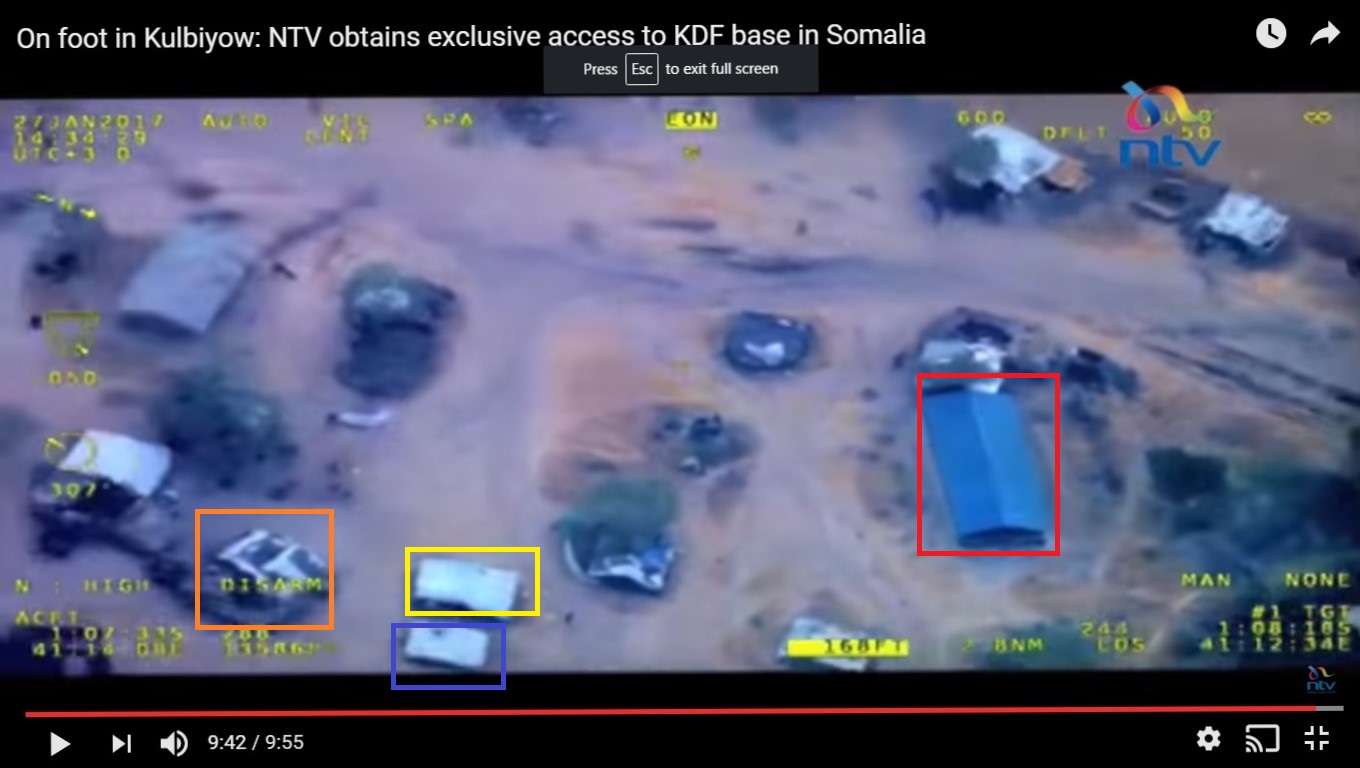
Imagery via Kenya NTV: On foot in Kulbiyow: NTV obtains exclusive access to KDF base in Somalia
The distinctive black-patched tarp of the mortar position (orange), striped tarp emplacement (blue), plain white tarp emplacement (yellow) and blue roofed building (red) appear to be the same locations in the drone and NTV footage. While the same mortar position shown in the NTV footage does not appear in al-Shabaab photos from the attack, a similar blue roofed building (enlarged below) is featured prominently in several frames.
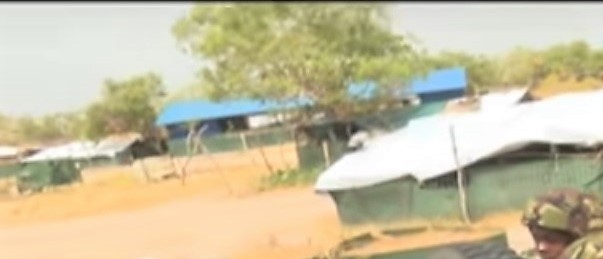
Imagery via Kenya NTV: On foot in Kulbiyow: NTV obtains exclusive access to KDF base in Somalia
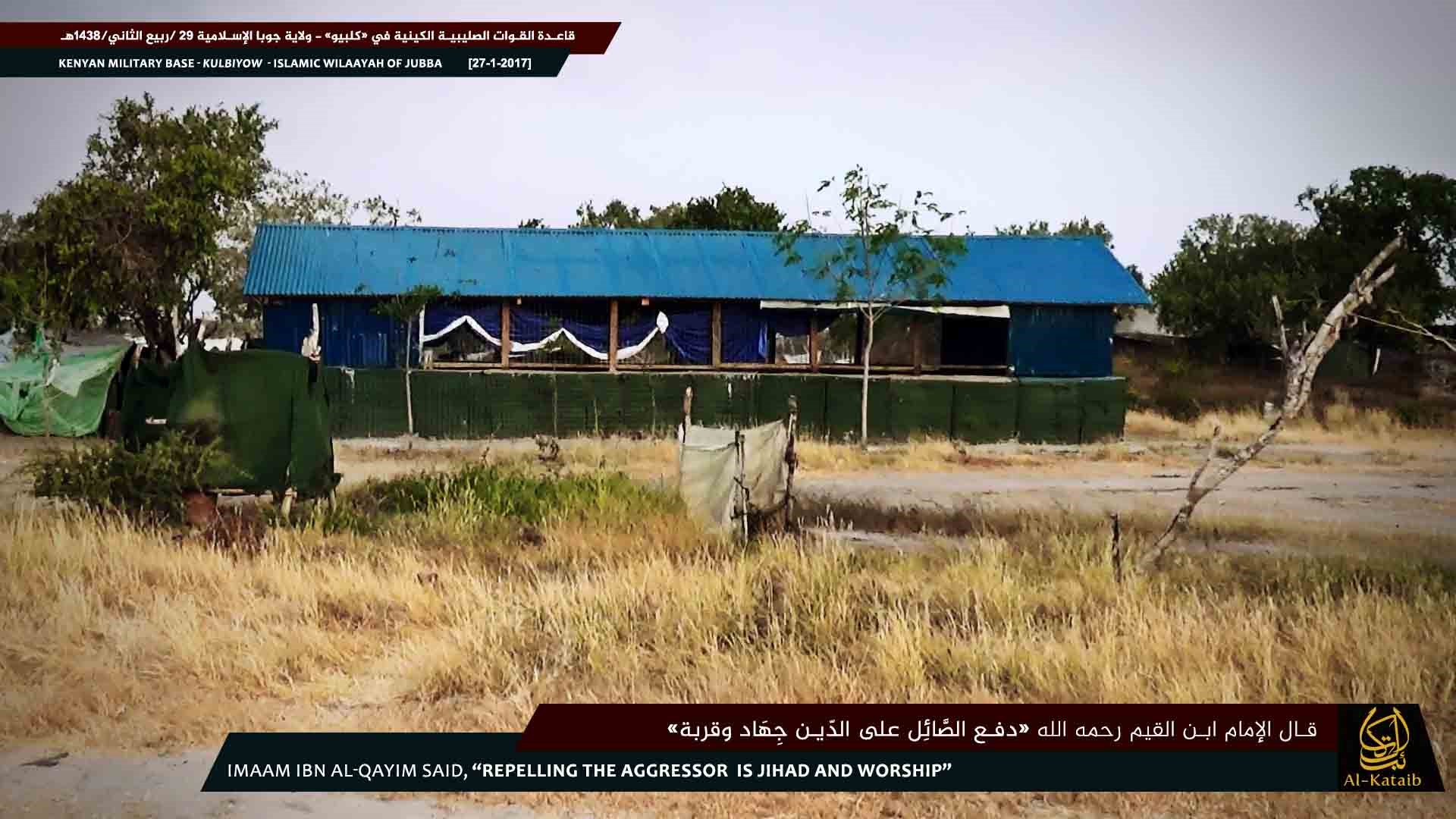
Imagery via Al-Kataib Media
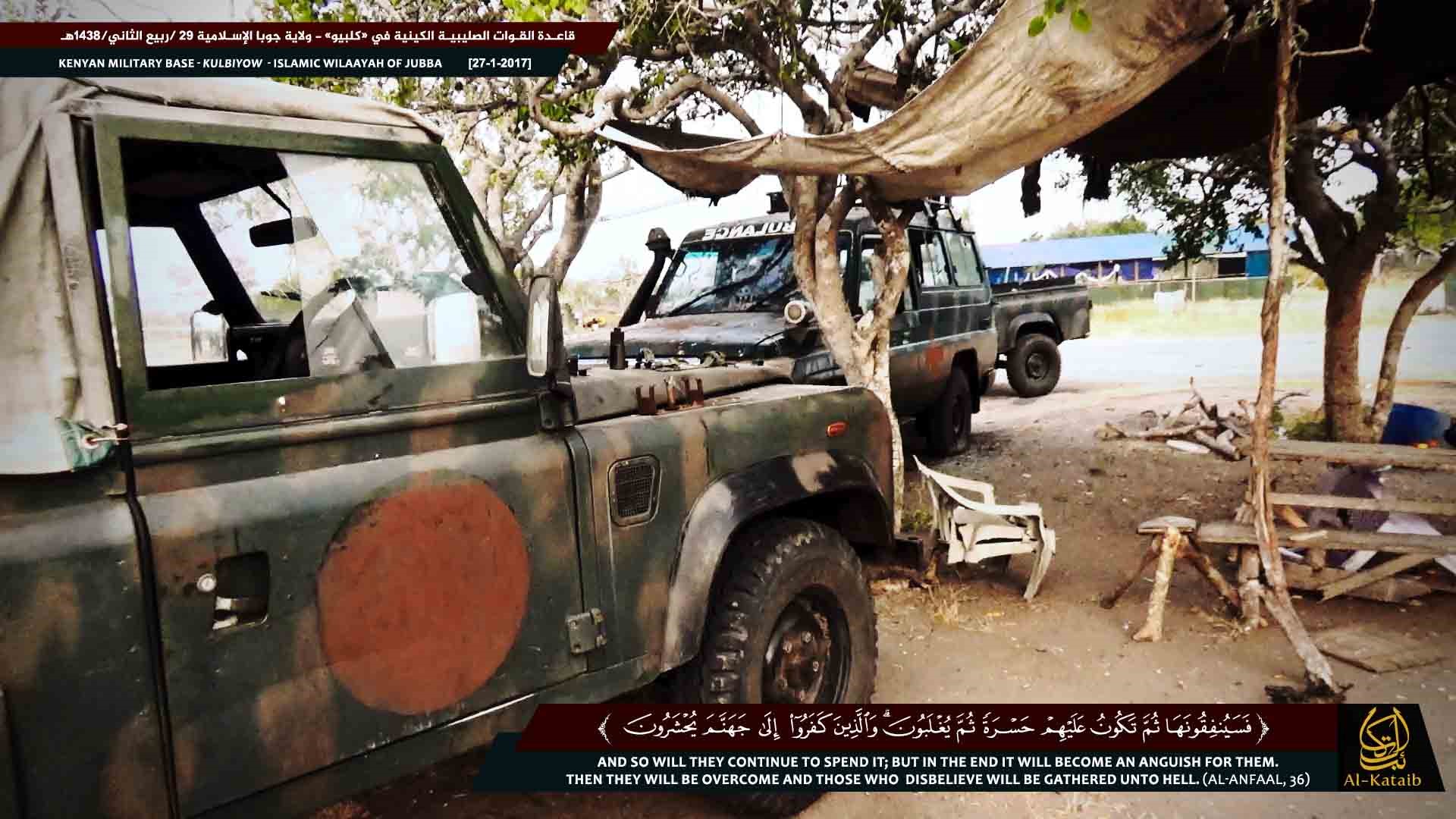
Imagery via Al-Kataib Media
Another image from inside, shows that it apparently functioned as an improvised chapel for the garrison, with chairs labeled “church” and apparently as a further indicator of the location, “Kolbio” (an alternate spelling of Kulbiyow).
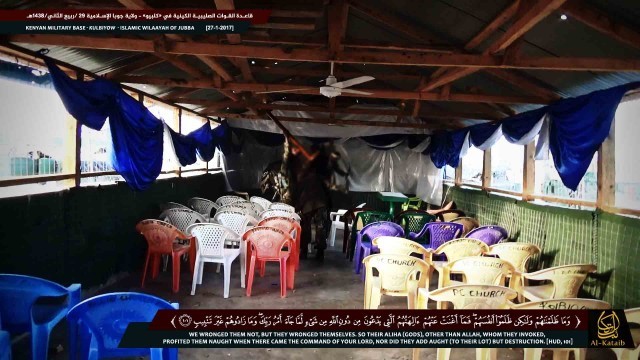
Imagery via Al-Kataib Media
A still taken from the drone footage, slightly to the east of the mortar position, showing three Steyr Sinotruck troop transport trucks with one facing south, and two facing north (yellow) and an oil transport truck (red), matching with another al-Shabaab image.
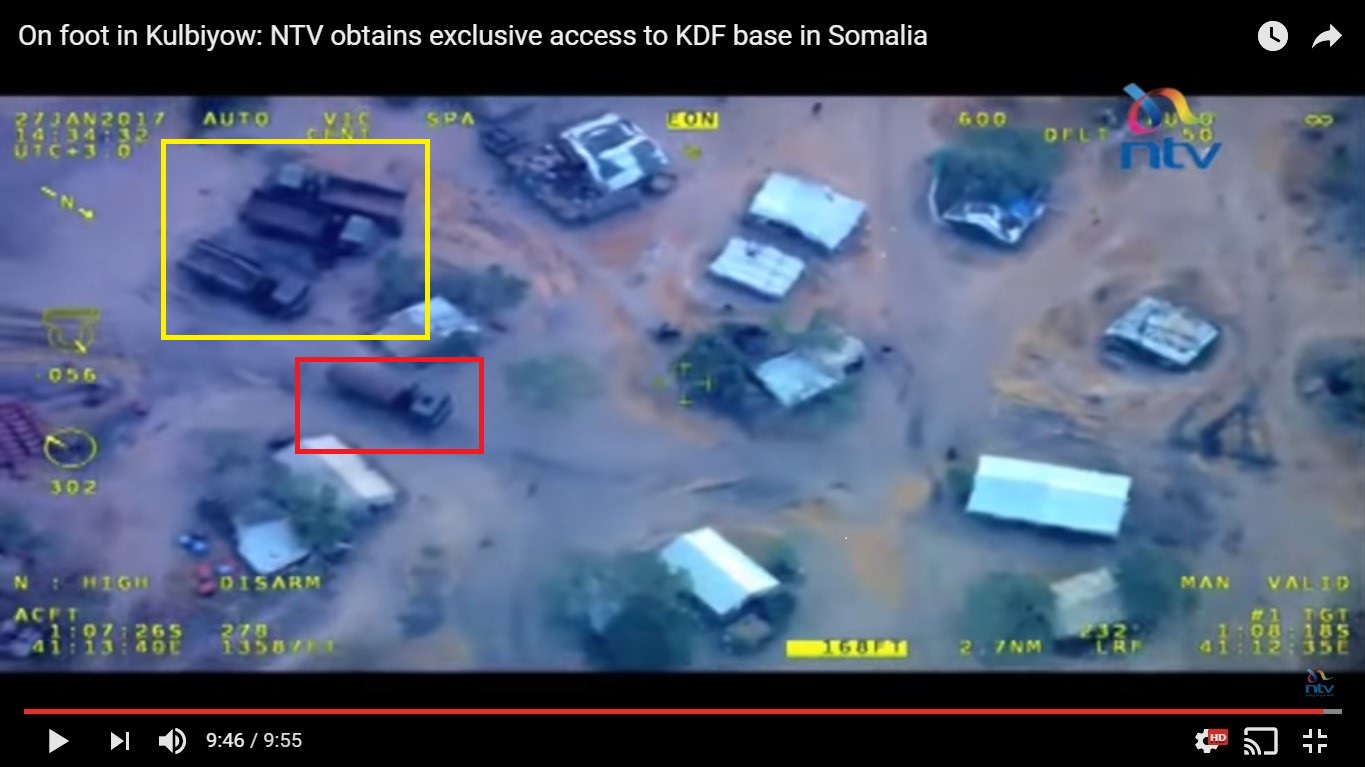
Imagery via Kenya NTV: On foot in Kulbiyow: NTV obtains exclusive access to KDF base in Somalia
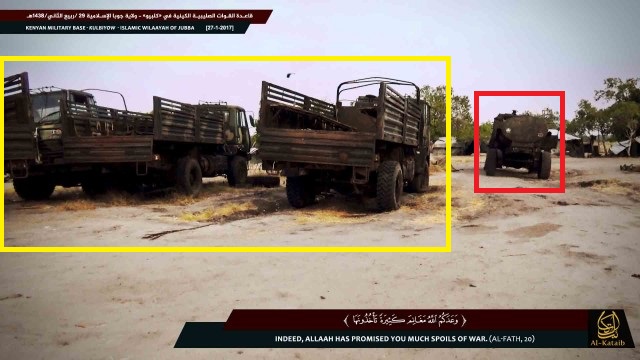
Imagery via Al-Kataib Media
Another drone image from video (at the 9:29 mark), near the northern perimeter of the base, shows an improvised white roofed structure (yellow), a Humvee (red), a tree with a box structure (black) and a troop transport (blue), matching with two separate al-Shabaab photos from different angles.
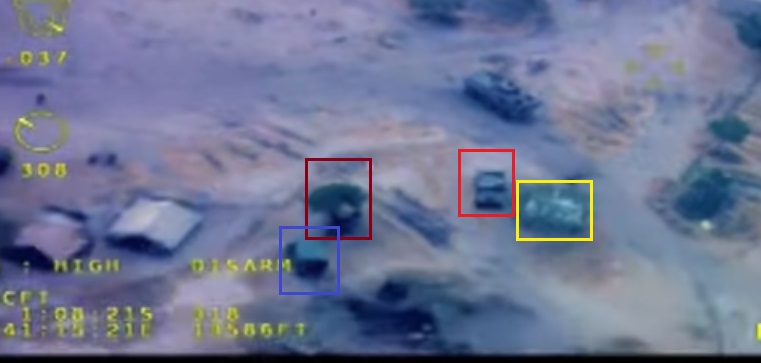
Imagery via Kenya NTV: On foot in Kulbiyow: NTV obtains exclusive access to KDF base in Somalia
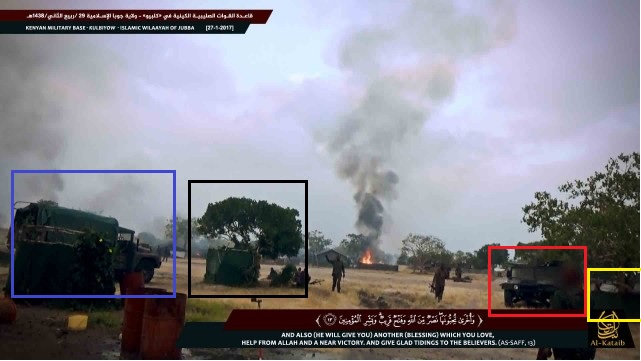
Imagery via Al-Kataib Media
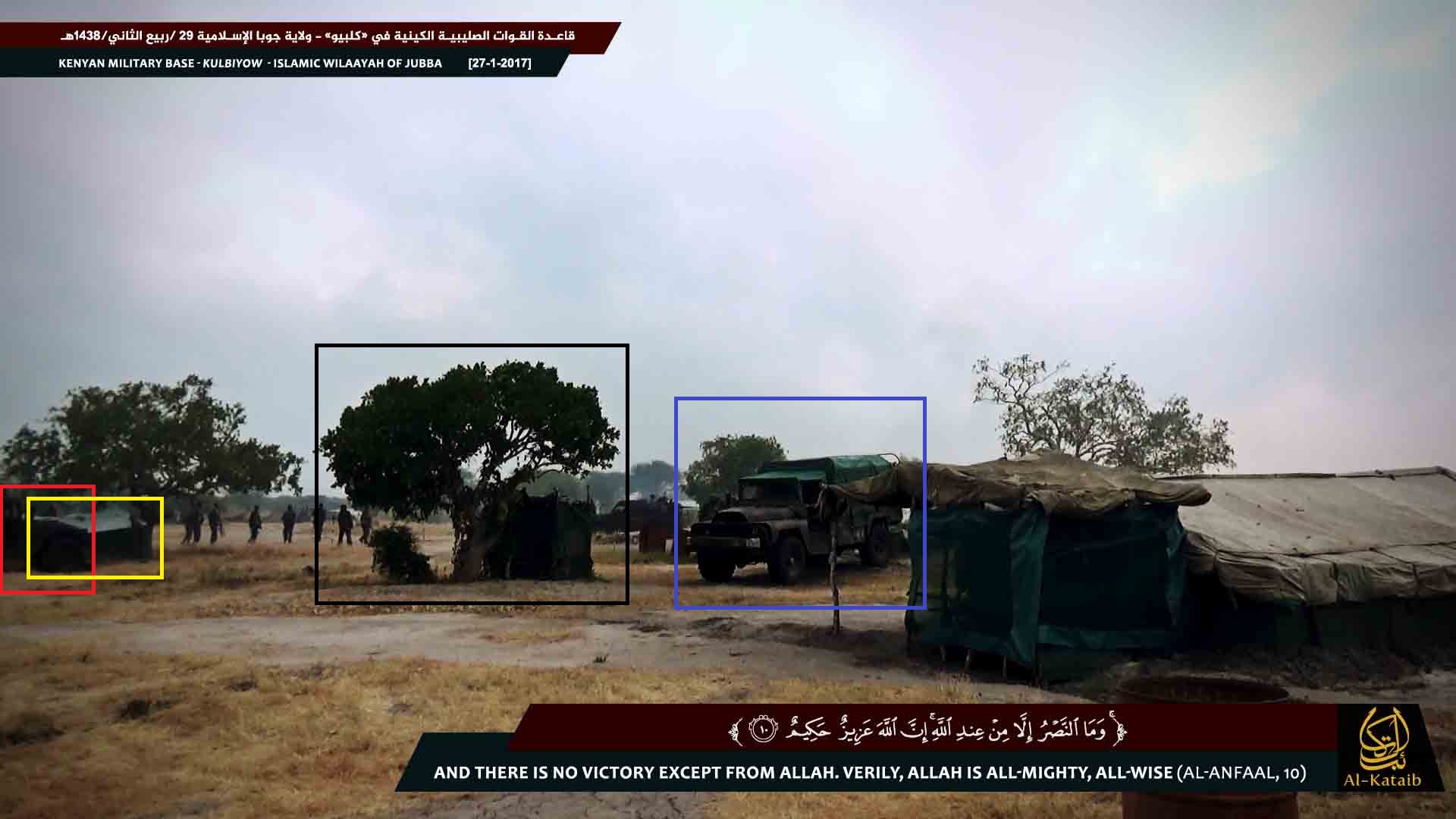
Imagery via Al-Kataib Media
Another frame to the east of the previous image shows a KDF mine resistant ambush protected vehicle (red), or MRAP, behind an earthen defensive berm framed by two white tents (yellow and blue).
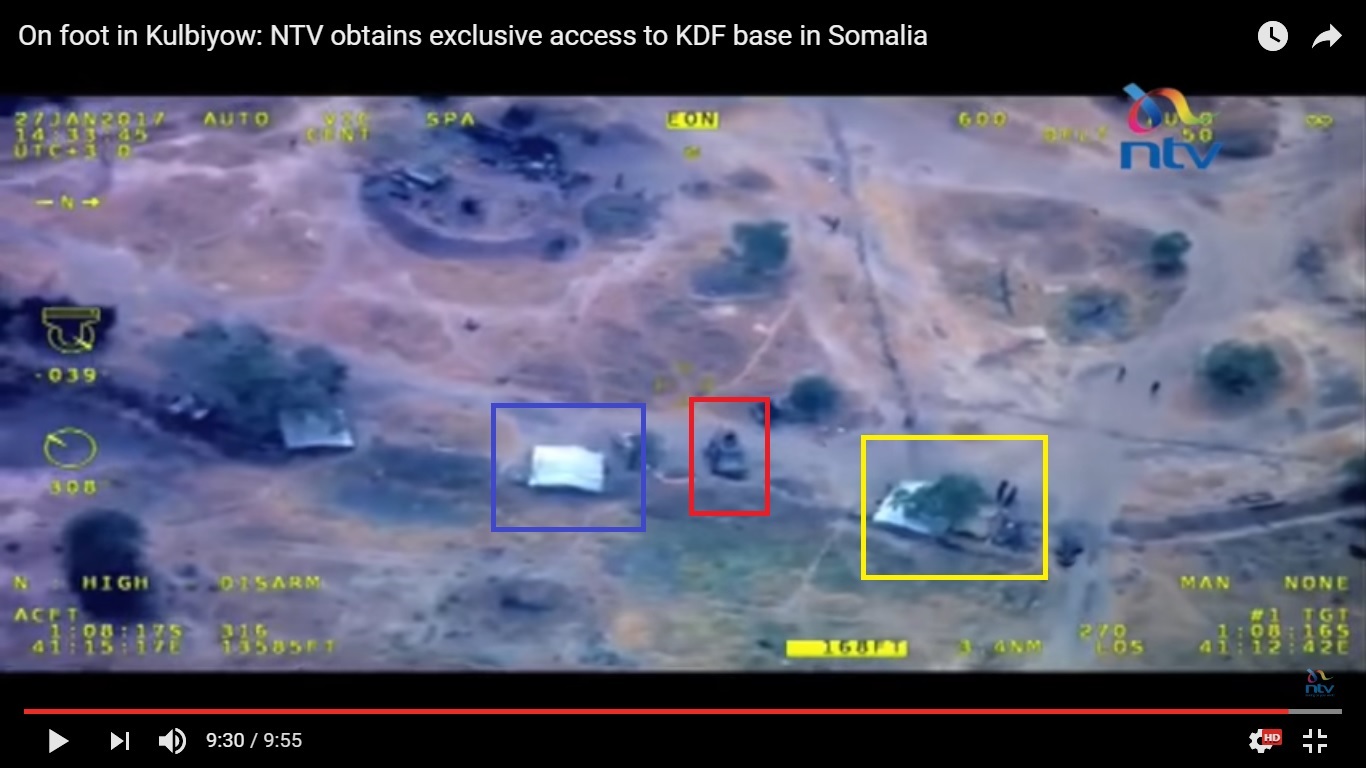
Imagery via Kenya NTV: On foot in Kulbiyow: NTV obtains exclusive access to KDF base in Somalia
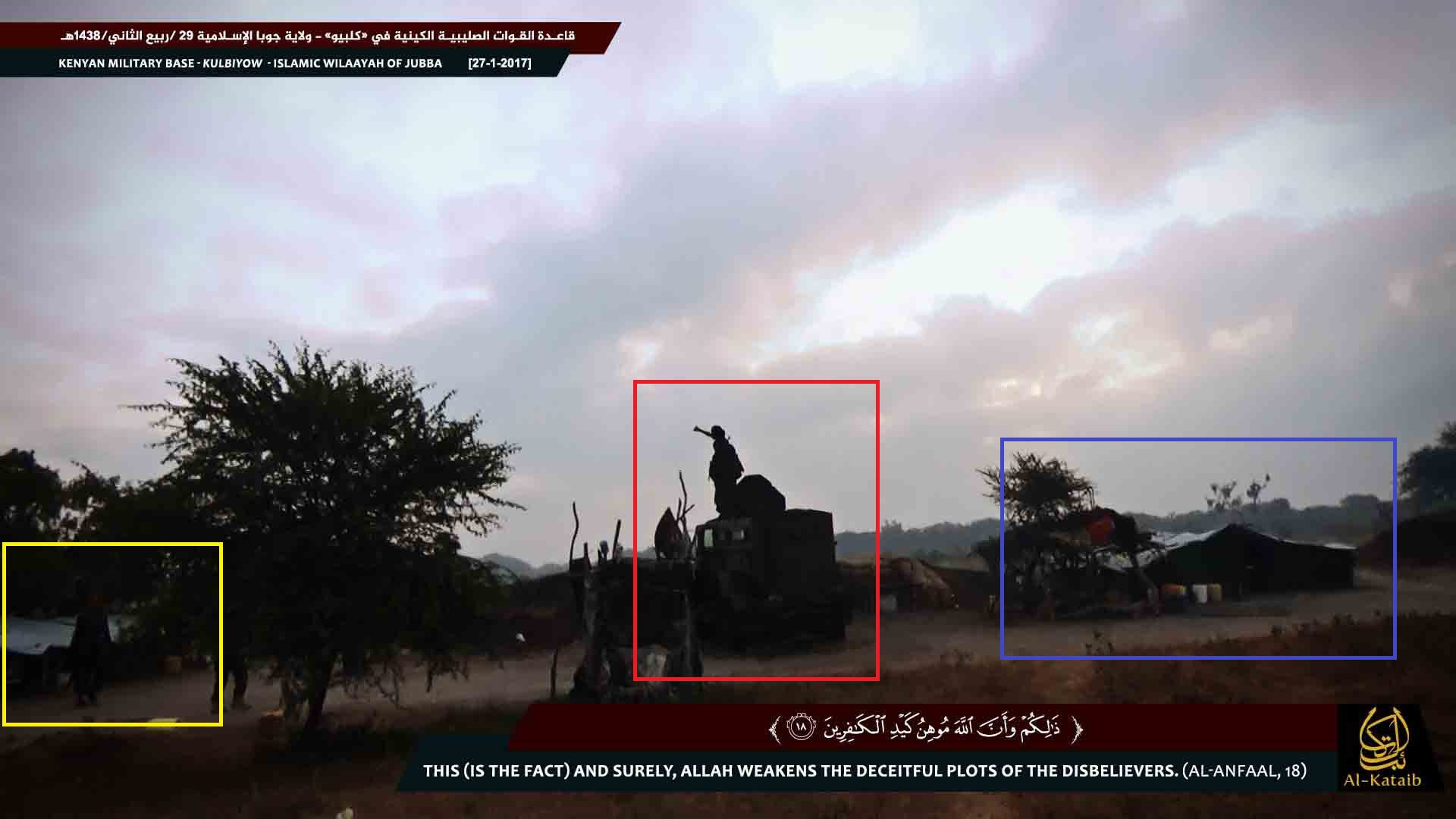
Imagery via Al-Kataib Media
The tent on the left in the previous picture (yellow box) matches with another al-Shabaab photo, showing an entrance to the base and a defensive position in earthen barrier (red). The KDF APC in the photo is missing in the drone footage.
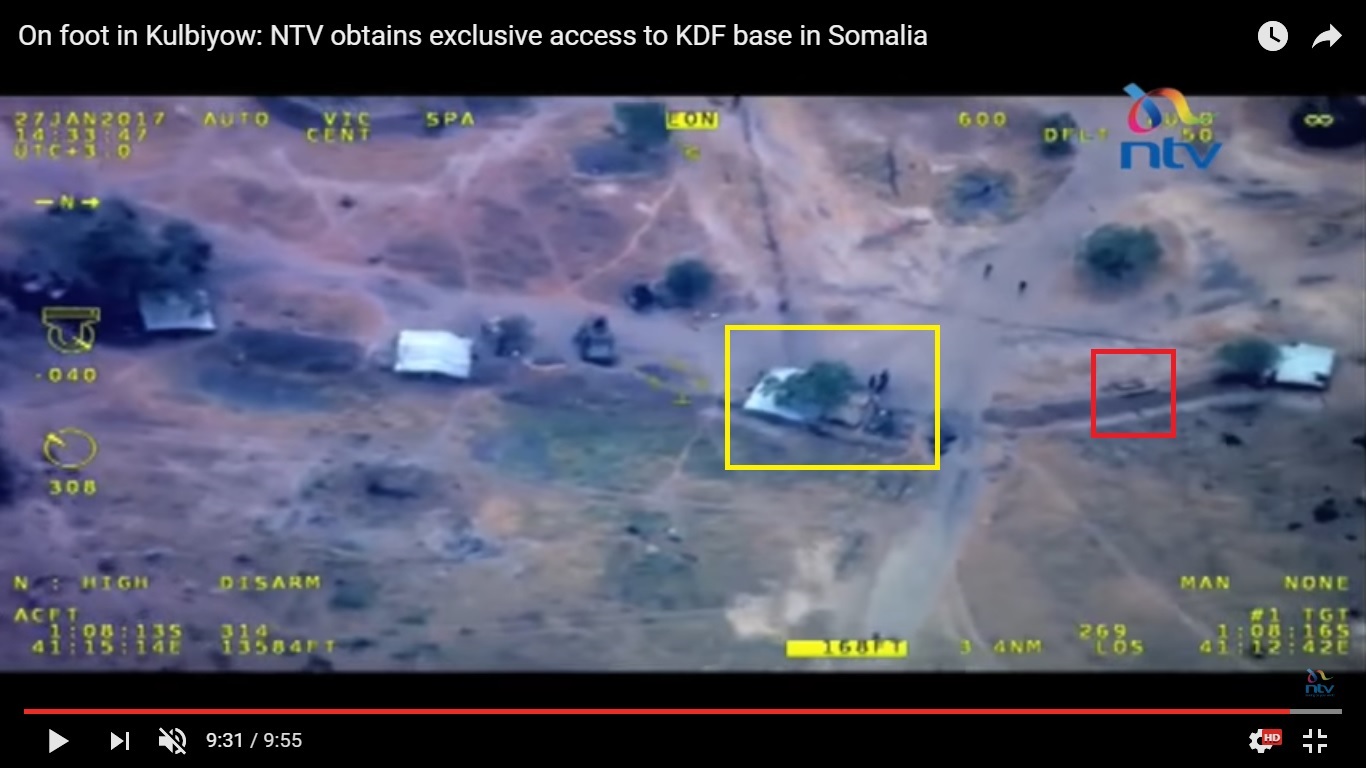
Imagery via Kenya NTV: On foot in Kulbiyow: NTV obtains exclusive access to KDF base in Somalia
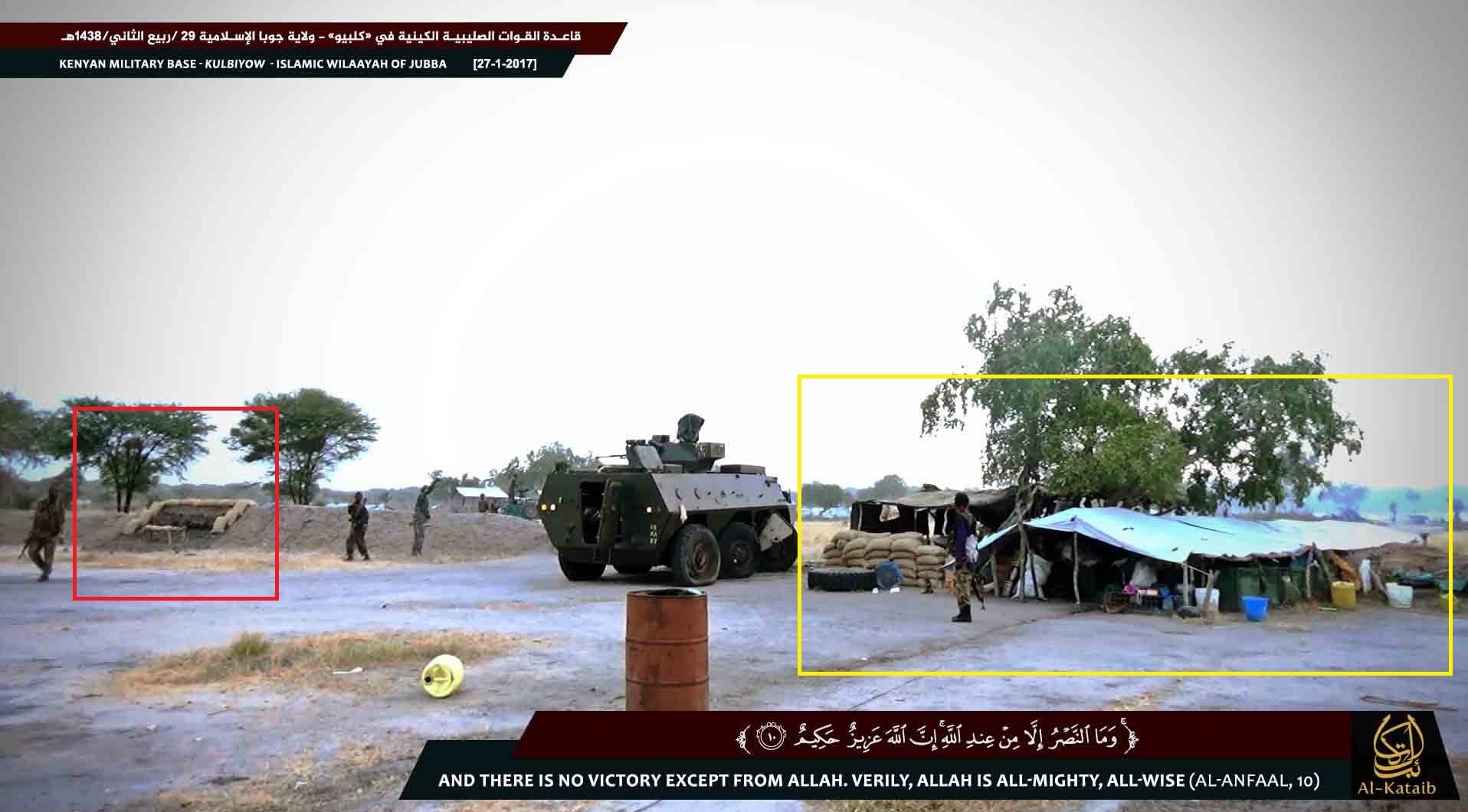
Imagery via Al-Kataib Media
Further along the defensive perimeter, a Kenyan MRAP with its rear door ajar (red) and two white roofed defensive positions (yellow and blue) matches with an al-Shabaab photo.
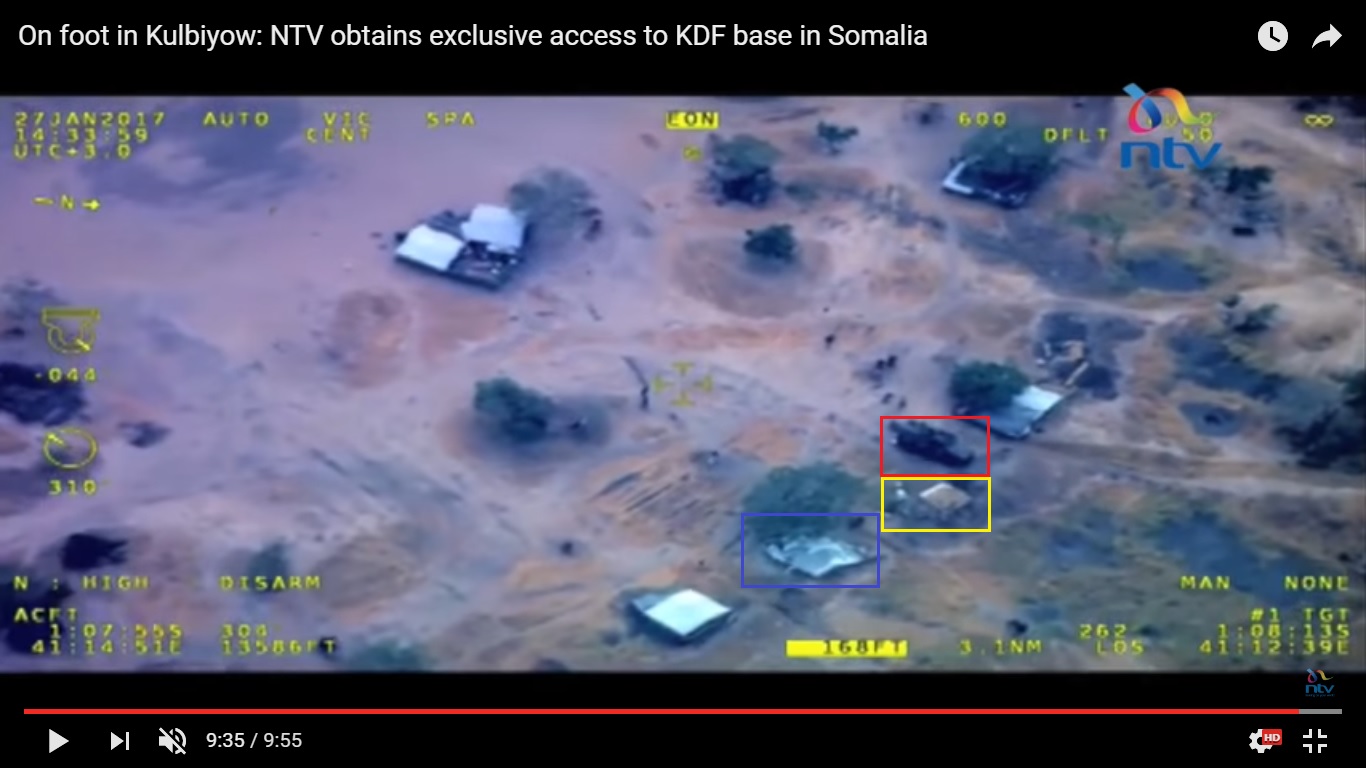
Imagery via Kenya NTV: On foot in Kulbiyow: NTV obtains exclusive access to KDF base in Somalia
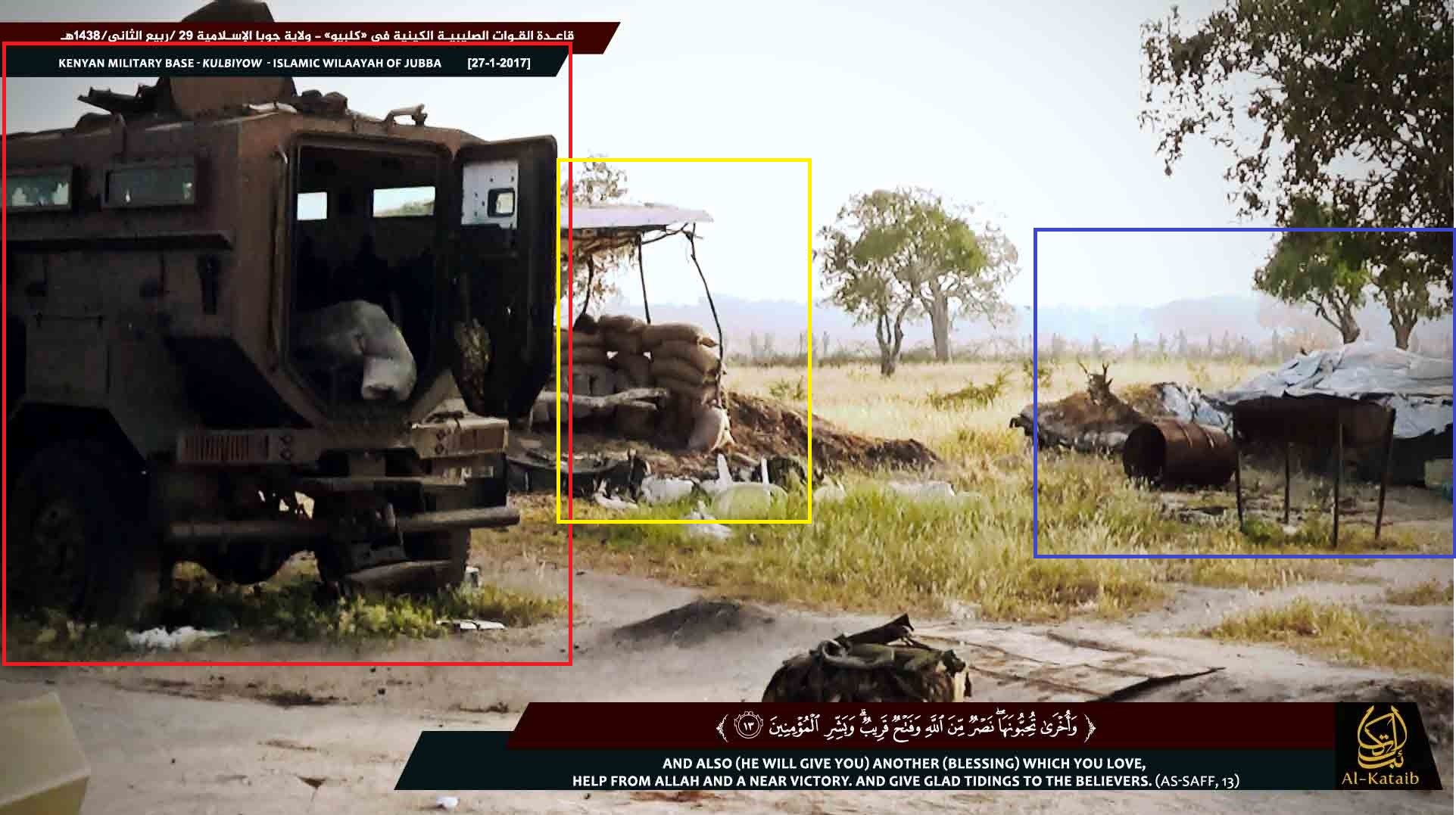
Imagery via Al-Kataib Media
Coming to Conclusions
While the drone footage was not able to verify the entirety of the al-Shabaab’s photo set, it raises doubts about the Kenyan government’s official story. A significant number of photos released by al-Shabaab match with locations throughout the Kenyan government’s drone footage of the Kulbiyow military base. This shows that rather than being repelled by the defenders, al-Shabaab was able to breach the base’s perimeter and move freely within. Al-Shabaab took photos at various points across the entirety of the base (see composite of drone footage and al-Shabaab photos below), not just concentrated within one sub-section. Furthermore, if several images from the photoset appear to be authentic and from Kulbiyow, it lends credence to the validity of the larger photoset. As the photoset contains dozens of corpses of KDF soldiers, it challenges the government assertion that only nine soldiers were killed.
While these images may provide a general picture of what occurred at Kulbiyow, they cannot confirm all of the details within Kenyan and Somali media accounts. As in the past, al-Shabaab has curated the photos it released to exclude any displays of their own casualties. Additionally, while a large number of the photos appear to be taken at dusk, corresponding with firsthand accounts, they do not show how long militants were in control of the base. While the drone imagery is supposedly from 2:35pm on Jan 27, it is not clear if this was before or after militants had vacated the base. As an indication of the latter, several vehicles from al-Shabaab’s photoset are missing from the same locations in the drone footage, matching accounts that al-Shabaab absconded with captured vehicles after withdrawing.
As in the case of the el-Adde, much of the information on the attack on Kulbiyow came from anonymous firsthand accounts and al-Shabaab propaganda. The continued obfuscation on details regarding major al-Shabaab attacks by the Kenyan government allows al-Shabaab to seize the narrative of events. Additionally, it stifles attempts at accountability that could potentially mitigate future risks to Kenyan soldiers. The Kenyan government’s refusal to acknowledge publicly the large numbers of soldiers killed, or tactical shortfalls in major battles, precludes their willingness for investigations and accountability.
